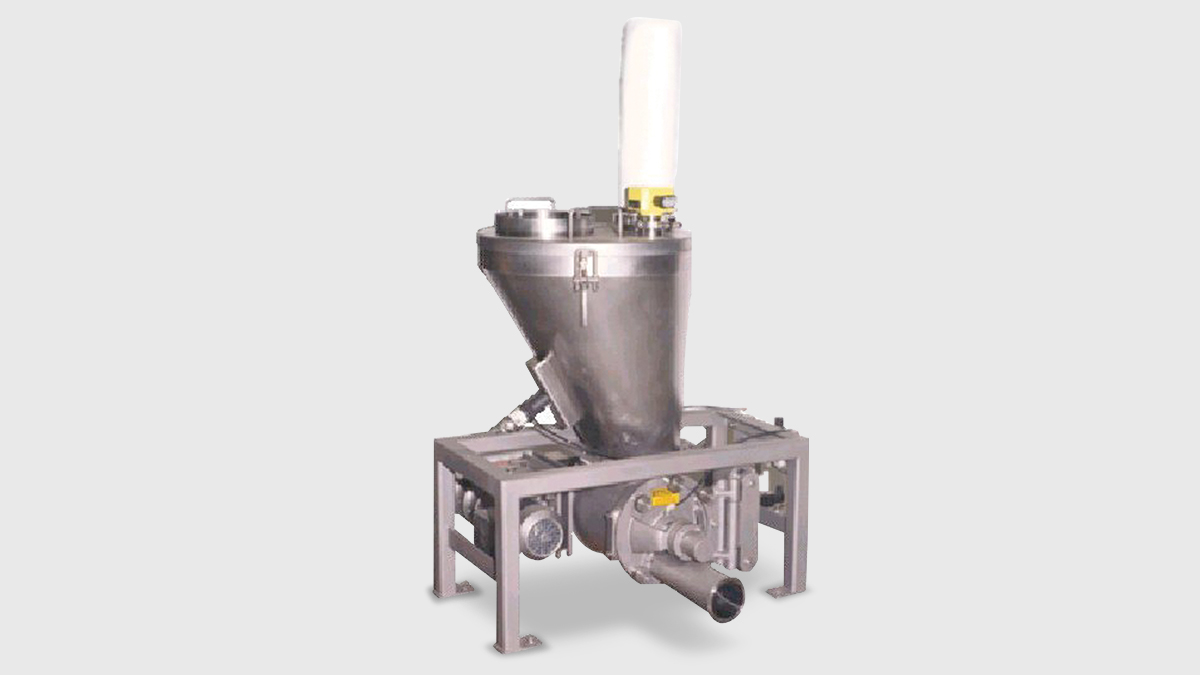Dense Phase
Vacuum Conveying - Dense Phase
Dense phase vacuum conveying systems use high capacity vacuum pumps (up to 99% vacuum) to convey materials from a feed hopper or silo to a receiving vessel or vacuum hopper where the air and product are separated by a filter.

Systems
Systems generally operate on a batch basis, as follows:
- the vacuum pump draws powder to the vacuum hopper until full
- the vacuum isolation valve closes and the discharge valve opens
- conveyed powder is emptied from the vacuum hopper
- the discharge valve is closed and the cycle repeats.
Valves and sensors are used throughout the process to control the applied vacuum, product fluidization settings and system velocities to ensure trouble-free product conveyance.
Applications
Dense phase vacuum conveying is particularly suitable for conveying high capacity materials over short to medium distances, from multiple sources to a single or multiple destinations. The low velocities and vacuum make it ideal for food, dairy and pharmaceutical applications involving friable or fragile agglomerates.
Specifications
| Convey Rates: | < 20 tonnes/h. |
| Convey Distances: | up to 100 m |
| Air mover: | vacuum pump (dry vane, oil or water sealed) |
| Operating Pressure: | <99% vacuum |
| Air Ratios: | medium |
NB: All values are approximate: please contact GEA for advice about how to convey your product.
Options
To optimize the system, various techniques can be used and additional options for specialized applications are available:
- feedback velocity control systems to minimize product degradation
- pulsed air injection to break up the product flow into discrete slugs
- twin receiving vessels to provide continuous conveying
- stainless steel construction for sanitation or corrosion resistance
- demountable and polished designs to USDA 3A standards for ease of cleaning
- multiple inlet/outlet networks for maximum flexibility.
Downloads
Related Products

Pressure Conveying - Dense Phase
Dense phase pressure conveying systems use compressed air to push materials from a single or twin pressure pot system through a pipeline to a destination where the air and product are separated.

Vacuum Conveying - Lean Phase
Lean or dilute phase vacuum conveying systems generally use positive displacement exhausters to provide a vacuum (up to 50%) to convey materials through a pipeline to receiving vessel where the air and product are filtered and separated. Lower capacity fan-based systems are also available.

Pressure Conveying - Lean Phase
Lean or dilute phase pressure conveying systems use positive displacement blowers —providing air at up to 0.6 Barg — to convey materials through a pipeline to a destination where the air and product are separated by a filter.
Related Videos
GEA Powder Handling Test Center - Test Before You Invest
GEA Insights India
All pharmaceutical freeze-drying vials are the same! Aren't they?
Whether it’s a fad or the future, 100% vial traceability is becoming an increasingly important consideration in the pharmaceutical freeze drying industry. Keeping a close eye on developments is GEA. We’re investigating possible solutions and, what’s more, we have the experience, expertise and know-how to implement them.
Alcohol-free beer: They want it all – they want less
There was a time when the phrases ‘non-alcoholic beer’ and ‘tastes good’ were seldom used together in the same sentence, particularly by consumers. But low-proof and alcohol-free beers have come a long way – many of them now refreshing drinks in their own right – thanks in no small part to technology from GEA.
Innovating patient care with aseptic spray drying
At GEA, our commitment to engineering for a better world fuels our pursuit of innovative solutions that enhance patient care and safety. One of our most promising ventures in recent years is aseptic spray drying – a technology that promises to revolutionize pharmaceutical manufacturing.